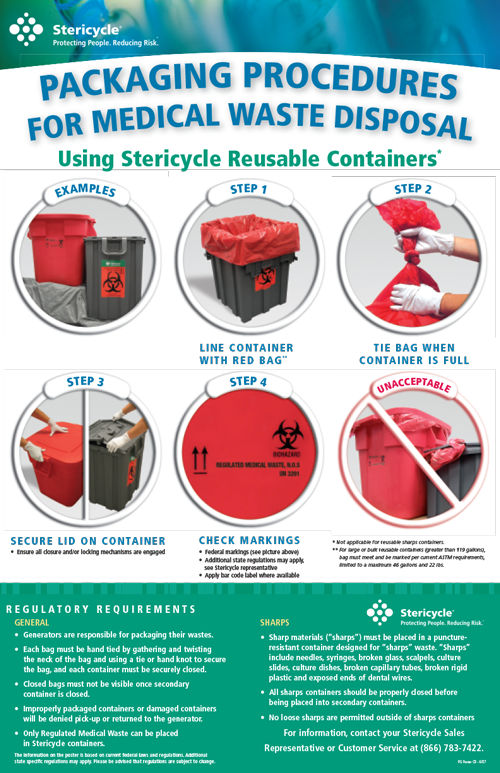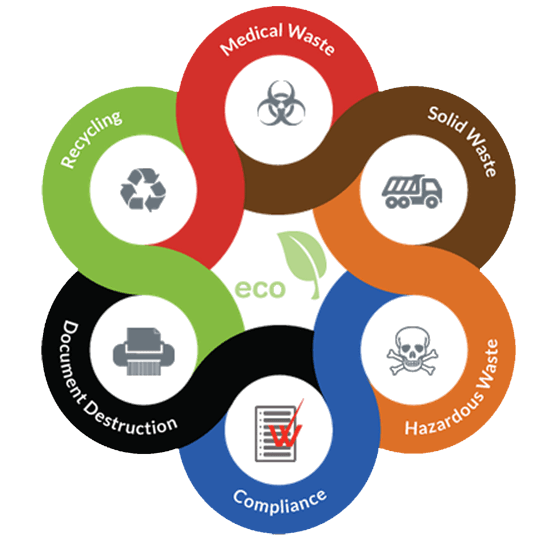Complete Medical Waste Removal Service: Smooth Disposal for Health Care Facilities
Compliance and Laws for Medical Garbage Disposal
Compliance and laws for clinical waste disposal play an essential function in making sure the security and wellness of both healthcare experts and the general public. Appropriate monitoring of medical waste is crucial to avoid the spread of infections, safeguard the atmosphere, and keep public health and wellness. These guidelines incorporate different elements, consisting of the classification and segregation of medical waste, correct storage space and dealing with treatments, as well as transportation and disposal techniques.
Value of Compliance
The value of conformity with regulations for medical garbage disposal can not be overstated. Appropriate disposal of clinical waste is vital for guaranteeing the safety and security and health of healthcare employees, individuals, and the general public. Medical waste, that includes things such as made use of needles, infected gloves, and biomedical waste, can present significant wellness risks if not taken care of and taken care of properly.
Compliance with policies makes sure that medical waste is taken care of in a method that minimizes the possibility for exposure to hazardous substances and infectious illness - medical waste disposal. It aids avoid the spread of infections, such as HIV, hepatitis B and C, and various other bloodborne microorganisms. Conformity additionally plays a vital duty in safeguarding the setting by preventing contamination of water resources, dirt, and air
Failing to adhere to regulations can result in severe effects for healthcare centers, consisting of fines, lawful action, and damages to their online reputation. In addition, non-compliance may compromise the health and wellness of healthcare employees, individuals, and the area.
Conformity with regulations for clinical garbage disposal requires adherence to particular guidelines and protocols. These may include correct partition, product packaging, labeling, and storage space of medical waste. It likewise includes making use of accepted disposal approaches, such as landfilling, autoclaving, or incineration, depending on the sort of waste.
Governing Agencies and Bodies
Governing firms and bodies play an important role in supervising conformity with policies for medical garbage disposal. These companies are accountable for setting guidelines, protocols, and requirements to make certain the proper and risk-free handling of clinical waste. They impose and keep an eye on conformity to shield public health and the environment.
One of one of the most popular regulatory companies in the United States is the Environmental Security Agency (EPA) The EPA is accountable for controling the storage, transport, therapy, and disposal of clinical waste. They establish standards for waste generators, carriers, and treatment centers to adhere to, making certain that all necessary preventative measures are required to avoid the spread of diseases and contamination.
An additional essential regulative body is the Occupational Safety And Security and Health Management (OSHA) OSHA establishes requirements and regulations to secure employees from occupational threats, including those associated to medical waste. WasteX Medical Waste Disposal. They offer guidelines for the risk-free handling and disposal of medical waste to shield employees in healthcare centers
Along with these government agencies, private states additionally have their own regulative bodies that look after clinical garbage disposal. These agencies may have their own certain laws and needs that have to be complied with.

Category and Partition of Medical Waste
To make sure proper monitoring of clinical waste, it is important to categorize and segregate it according to established procedures and standards. medical waste disposal service. Category and partition play a critical role in decreasing the threat of infection, protecting the setting, and making sure the safety and security of medical care workers and the basic public
Clinical waste is categorized into various groups based upon its prospective danger level. These categories consist of transmittable waste, pathological waste, sharps waste, pharmaceutical waste, chemical waste, and radioactive waste. Each category requires specific handling, disposal, storage space, and transportation methods to lessen the threat of exposure and contamination.
Partition of clinical waste entails separating various kinds of waste at the source. This procedure makes sure that waste with various threat degrees is not blended, lowering the possibility for cross-contamination and making disposal treatments more reliable. Appropriate segregation is accomplished via the usage of color-coded containers and labels, which aid medical care workers and waste administration employees handle each type and recognize of waste properly.
In addition to category and partition, health care centers need to likewise abide by local, state, and federal policies pertaining to clinical waste administration. These guidelines lay out details needs for storage, transport, therapy, and last disposal of clinical waste, making certain conformity and maintaining public health and security.
Proper Storage Space and Taking Care Of Procedures
Correct storage space and handling treatments play an important role in making certain the compliant and safe management of clinical waste. Clinical waste, which consists of things such as utilized syringes, infected handwear covers, and expired medicines, can posture significant health and ecological threats otherwise managed appropriately. Consequently, it is crucial for medical care centers and various other generators of medical waste to carry out stringent storage and taking care of protocols.
To start with, clinical waste ought to be stored in sturdy, watertight containers that are especially developed for this objective. These containers ought to be labeled with the universal biohazard symbol and the words "clinical waste" to clearly indicate the components. Furthermore, the containers ought to be maintained securely near to protect against any kind of prospective leakage or spillage.
Furthermore, it is very important to segregate various kinds of medical waste to avoid cross-contamination. Sharps, such as needles and scalpels, must be stored in puncture-resistant containers to decrease the risk of injuries - WasteX Medical Waste Disposal. Chemical waste, such as anti-bacterials and solvents, must be kept individually from other sorts of medical waste to stop dangerous direct exposures or chemical responses

Transportation and Disposal Methods
Healthcare centers need to ensure the safe transport and correct disposal of their medical waste to follow guidelines and shield public health. Transport and disposal techniques play a critical duty in avoiding the spread of infectious illness and minimizing the ecological impact of clinical waste.
To transfer medical waste, medical care facilities need to use puncture-resistant and leak-proof containers that are labeled with the biohazard symbol. These containers ought to be firmly sealed to avoid any leakage during transport. Furthermore, healthcare facilities must develop procedures for the transportation process, consisting of the use of dedicated automobiles and qualified personnel.
Once the medical waste reaches the disposal center, it undertakes various techniques of treatment. One usual technique is incineration, which includes shedding the waste at high temperature levels to damage pathogens and decrease the quantity of waste. Another method is autoclaving, which uses heavy steam and pressure to decontaminate the waste. After treatment, the waste is usually sent out to a landfill or a waste-to-energy center for final disposal.
It is necessary for health care centers to collaborate with certified and allowed waste management firms to ensure correct transportation and disposal of clinical waste. These business have the knowledge and resources to take care of medical waste safely and in compliance with guidelines.
Final Thought
In final thought, compliance with regulations for clinical waste disposal is of utmost significance to guarantee public wellness and safety. In general, adherence to compliance and policies is required to successfully manage medical waste.
Clinical waste, which consists of products such as made use of needles, contaminated gloves, and biomedical waste, can pose major health threats if not managed and disposed of effectively.
These classifications consist of contagious waste, pathological waste, sharps waste, pharmaceutical waste, chemical waste, and contaminated waste.Segregation of clinical waste involves dividing different types of waste at the resource. Appropriate segregation is achieved with the use of color-coded containers and labels, which aid health care employees and waste administration workers manage each type and recognize of waste properly.
Chemical waste, such as disinfectants and solvents, should be stored individually from other kinds of medical waste to stop dangerous direct exposures or chemical responses.